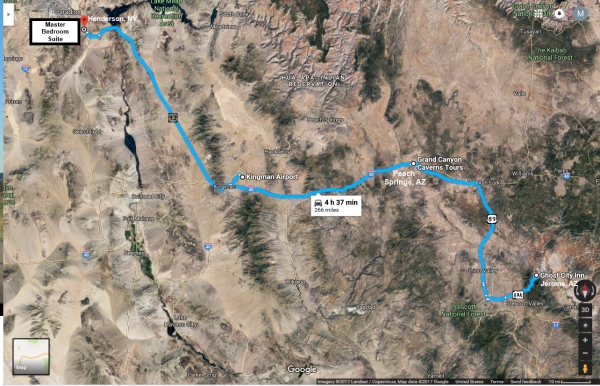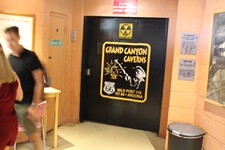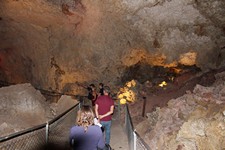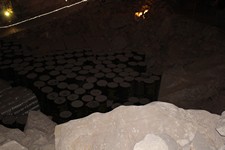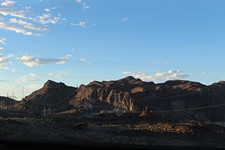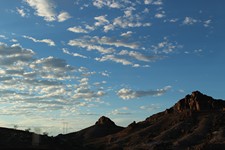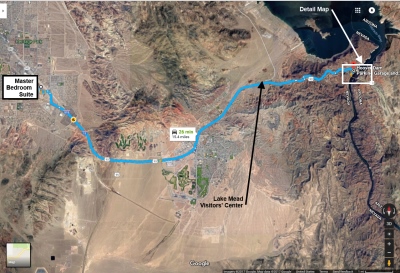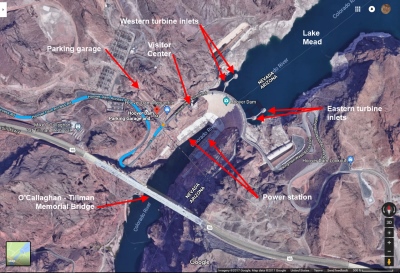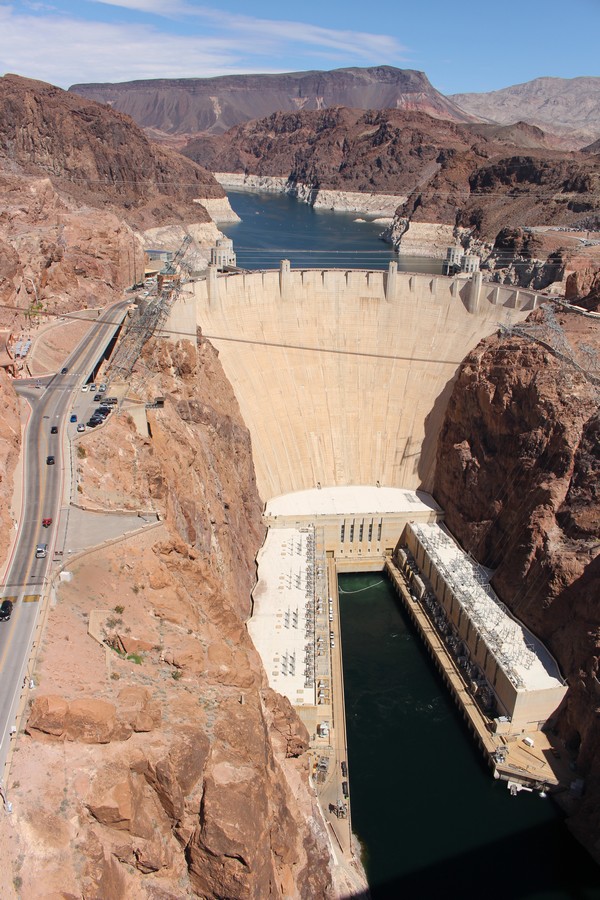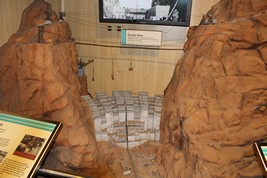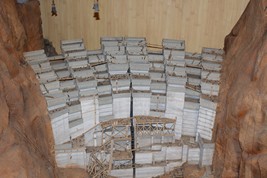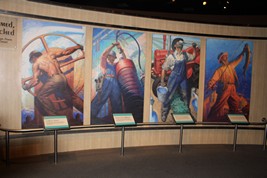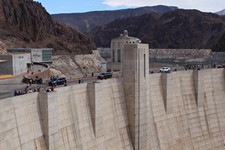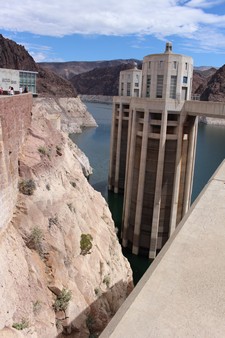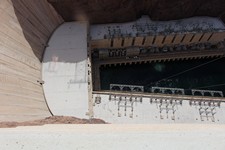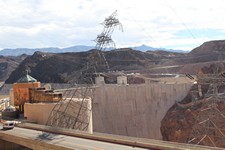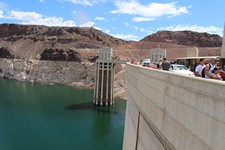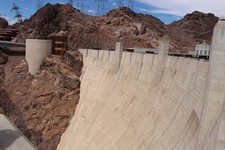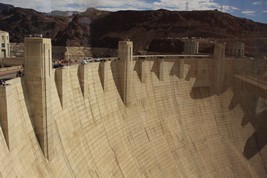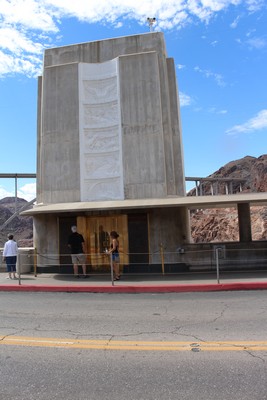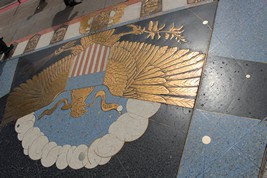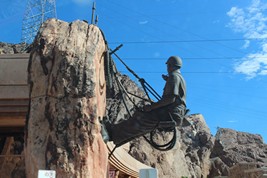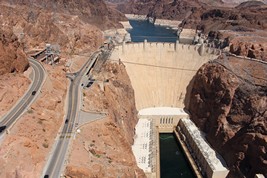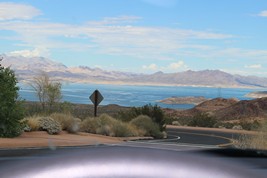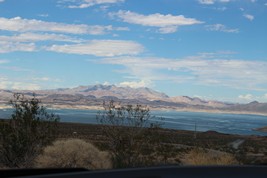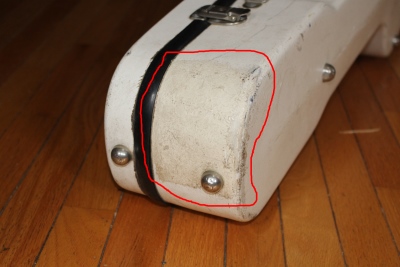Southwest Vacation
Part 5: Henderson NV and Hoover Dam
(Note: Clicking on any image in this travelogue will bring up a full screen version of the image.)
Tuesday, September 12
Jerome AZ - Henderson NV
So today was the long drive. Our destination was Henderson, Nevada, just a little south of Las Vegas, which we would use as our base point for a visit to Hoover Dam. But there were one or two interesting stopovers along the way.
Grand Canyon Caverns
|
We stopped for lunch and a tour of Grand Canyon Caverns in Peach Springs. Grand Canyon Caverns is the largest dry underground natural cave complex in the US, and perhaps in the world. By "dry", I mean that unlike most cave systems where ground water has dissolved limestone to produce voids in the rock structure, there is no active water currently at work in the system. So the cavern is pretty much stable and unchanging, and there are no stalagmites and stalactites.
(By the way, my favorite mnemonic to remember which is which is that it's like ants in the pants: The mites go up and the tights come down. Close parentheses.)
They were discovered in 1927 by a man named Walter Peck, who, after filing a prospectors claim to the caverns and failing to find gold in them, marketed them as a tourist attraction. In the 30s the WPA enlarged the facilities as part of the effort to put people to work during the Depression. The facilities have since been expanded to include a restaurant and motel.
The basic public tour is quite civilized, and easy to negotiate. With access by a large elevator (Photo 010), and passages enlarged and paved, and provided with sturdy railings (Photos 030 and 040), most of it is even wheelchair accessible. The temperature is a constant 57°F, and humidity 2%. There are, however, other areas in the Caverns, not included in the general public tour, where guides will lead more serious spelunkers through more technically challenging areas of the Caverns. Those same guide are the ones that lead the public tours. And consequently the tour was mercifully free of kitchy touristy silliness, and rich in serious geological and historical information. (Well, there were the two lost cave men shown in Photo 050, but they didn't make a big thing of it.) In 1962 during the Cuban Missile Crisis, the US Government designated the Caverns as a fallout shelter, with supplies for 2,000 people (Photos 060 and 070). They're still there. And the low humidity and temperature makes for such a good environment for storage that they're still edible. (I wonder if they also kept any wine there.). Another entertaining feature is the Honeymoon Suite (Photo 080), which is an unusual adjunct of the above-ground motel. It is a most exclusive, (and expensive) facility. When they close up for the night, they shut down the elevator. And when you turn off the lights, it gets dark. (They gave us a short sample.).
|
Back on the road, our route took us past Kingman, AZ. Jenny's father was stationed at Kingman Air Force Base during his service during World War II before she was born. So she wanted to stop by and see what, if anything, remained of that facility. We pulled off I-40 in Kingman, and followed signs to a Kingman Airport there. It seemed to be a typical rural commercial airport with a landing strip for private and commuter aircraft, and various terminals for DHL, UPS, and other shipping services. Driving along the service road, we saw nothing of the massive military facilities that existed there at the time of Jenny's father's service. But we stopped at the one-counter passenger terminal, and poked our noses in.
And sure enough, there was a pretty extensive display of memorabilia from that time. The primary purpose of the base had been gunnery training for the crews of the big 4-engined bombers that took part in the Allied air campaign over Europe. There were framed photographs of rows and rows of B-17 Flying Fortresses and other WW II aircraft. And there were scrap books showing photos of the extensive barracks, administrative buildings, and repair and maintenance facilities that occupied the grounds at the time. There were black-and-white panoramic photographs of aircrews all sitting on the wings of their aircraft before they shipped out. It was of great interest to Jenny in presenting a picture of her father as a young man just out of his teens in a situation that was to be a major event of his life. And it was also of great interest to me as a a buff of aviation of that period.
In addition to active airport air transport operations, Kingman is also the site of a gigantic aircraft "boneyard" to which scrapped obsolete aircraft are brought and stored. They are either cannibalized for parts or broken down and recycled for scrap metal. The low humidity of the region minimizes the inevitable deterioration that might occur to the planes. Had we the time, I might have enjoyed poking around that facility until Jenny got bored out of her mind. It's just as well we didn't have the time.
US Route 93
We hit the road, and shortly turned off I-40 onto US 93 North for the long straight slog to Henderson, just short of Las Vegas. Again that long-stare aspect of Southwestern American motoring hit me, as the road became a treadmill of desert and scrub vegetation that passed beneath our wheels as our vehicle sat stationary beneath an endless blue sky. It brought to mind a Norman Rockwell painting I once saw, depicting a "typical" American family on an outing on just such a road. Viewed from above they are all in a mid 50's convertible with the top down, two kids in the back seat making some kind of ruckus, mom in the passenger's seat frantically pointing back at the exit they've just passed, and screaming at dad, who is sort of hunched in the driver's seat reading the sign before them that reads, "Next exit 65 miles. No U-turn".
As we crossed into Utah, we finally saw some change in the road's elevation and direction, and the great strands of high voltage power lines indicative of the massive electrical power station at Hoover Dam, tomorrow's destination. We pulled into our next lodging around 8:00. This was a large private home in a recent development that Jenny had arranged for through VacationRentals.com, a competitive service to AirbnB. The facilities at this lodging stood in stark contrast to our cramped quarters in Flagstaff. Here we had not only an enormous master bedroom suite to ourselves with built-in bath and shower, but full run of the house, with use of kitchen and other facilities. We arrived just as the family was sitting down to dinner, and our host, Reynaldo graciously invited us to join them.
The family consisted of Reynaldo, and a large collection of offspring and extended family, but no "woman of the house" that I could discern. I never really got clear in my head how everyone was related to everyone else. But it appeared to be a remarkably well-adjusted family, with kids happily pitching in on the cooking and cleaning chores all posted on a calendar chart on the kitchen wall, applying themselves to homework with a will, and in general being so cheerful and polite that it was a little disconcerting. Reynaldo himself was a real go-getter, managing that house and several other rental properties, being an Uber driver, and sleeping on a pull-out couch in the living room while the kids all had their own rooms, and we occupied the master bedroom suite. I couldn't have been more delighted with his hospitality and the transient company of his family.
Wednesday, September 13
Hoover Dam
|
Detail map of dam. |
Hoover Dam is one of the great engineering accomplishments of the 20th Century. It was built by a conglomeration of private contractors called "6 Companies", and funded by the Federal Government during the Great Depression. Its triple purpose was putting men to work, providing a source of water for development of huge tracts of land in the arid Southwest, and providing electricity for that same area. It radically altered the landscape of the area by creating Lake Mead upstream of the Dam. And it made great swaths of Arizona, Nevada, Utah, and California inhabitable for a growing population. The story of its construction is the subject of countless books and documentary films. And it has always inspired the engineer in me. And the Dam itself is hugely impressive visually, and quite beautiful in my eyes.
Back in the mid 90s, Jenny had spent a summer with the Utah Shakespeare Festival in Cedar City, and I went out and visited her for a week. I had flown into Las Vegas, arriving there early in the day. And my plan was to rent a car, drive east to visit Hoover Dam, and then drive up to Cedar City to meet Jenny in the afternoon. Well, I picked up a nice little compact at Alamo Rent-a-Car, and struck out for Hoover Dam. I got about a mile when the engine died and refused to restart. I pushed it into a convenient gas station, and called Alamo from a pay phone. (No cell phones back then.) I asked them to come with another car and pick me up. "No, sorry. We can't spare a person do to that right now. We'll get there when we can." "How long might that be?" "We really can't say. Maybe an hour or two."
I blew up! I was 5 minutes from their &%^@#!! office, and one of their cars failed, and they couldn't spare a person to come get me. So I locked my luggage in the trunk, picked up my guitar in its heavy flight case, and lugged it back to the Alamo office in 110°+ temperatures. Needless to say, by the time I got there I was steaming in more ways than one. I barged into the office dripping sweat, and loudly let every customer in the place know what sort of vehicles they could expect from Alamo Rent-a-Car, and what sort of customer service they could expect when said vehicles crapped out. I must have been a sight! They managed to find another car, and someone to take me to the disabled vehicle, retrieve my luggage, go back to the office, and fill out the rental form, and send me on my way, glad to be rid of me. But by that time it was too late for me to take my side trip to Hoover Dam. Needless to say, I've never patronized Alamo since.
And, needless to say, I was really looking forward to finally getting to see Hoover Dam some 20 years later. And so it was with great anticipation that I pulled into the parking lot, and we hiked over to the Visitor Center. The Dam is a big juicy target for potential sabotage and terrorism, so security is pretty rigorous. We went through X-ray and bag searches. (There is a road along the top of the dam, which we did not take. I wonder if they do a search of every vehicle that crosses.) When we finally arrived at the gate, we found to my dismay that one of the elevators that took tourists to the inner workings of the Dam and the power plant was broken, and we would not be able to take the tour. Rats!
Visitor Center
Well, there was still plenty to see. The Visitor Center was rich with displays, including dioramas (Photos 160 and 170) and photos of the dam under construction, tools and artifacts from the construction itself, and artwork commissioned by the WPA along with the construction of the dam itself. Photo 180 show some mural panels commissioned to honor the dam workers who labored under terrible conditions to complete the work. It also had the blessed advantage of being air conditioned. The temperature outside was brutal.
The Dam
(If you click on the Detail Map of the Dam at the beginning of the Sept. 13 report, you can see where all these things are in relationship to each other.)
|
|||
|
We braved the heat to wander out atop the Dam. The overall size of the thing is staggering. Compare the size of the people on its crest to the Dam itself in Photo 230. And the photo only shows about the upper 2/3 of the structure. The traffic on the road running along the dam's crest was slow enough that crossing the road was quite easy, even in traffic. So one could look over the upstream side at Lake Mead, and then cross the road to gaze down at the power station and the turbine outlets so far below. The rampart-like projections shown in Photo 200 are observation platforms where one can get a good vertigo-inducing gander at the bottom. The power station at the bottom (Photos 210 and 240) contain not only the generators, but the transformers to crank the voltage up to levels in the region of 20,000 volts so as to more efficiently transmit the power along the lines to destinations hundreds of miles away. Those lines snake out of the canyon and out to Los Angeles and Phoenix and Denver over a forest of transmission towers (Photo 220), including the odd-looking canted towers (Photo 250) that appear to be ready to tumble into the river below. (Engineering explanation: If the tower were vertical, the tension from the horizontal wires on the left side of the tower would pull it over, because there is no corresponding horizontal run of wires on the right to counteract that force. So the tower is built to lean away from that horizontal pull. The combination of the horizontal pull on the left and the vertical pull on the right balance out into a force that is directly in line with the slanted axis of the tower.)
The water that drives the turbines is picked up in the four inlet towers shown in Photos 260 and 270. They lead to four huge 30 foot diameter pipes called penstocks at the base of the towers that go down to feed the turbines at the base of the dam. The water level in lake Mead upstream of the dam is 85 feet below capacity at the moment (Photo 280), but I'm told that other reservoirs behind dams upstream of Hoover are quite full, so there's no immediate danger of running low on water or power.
Artwork
Typical of federal public works projects of the 30s, intent and funds were included in the budget to beautify the project, and provide work for artists as well as laborers. Hoover Dam's decoration followed three main motifs: Art Deco, glorification of the worker, and Southwestern American Indian designs. The dam itself is a study in Art Deco (Photo 300). The spare graceful curve of the structure itself is beautiful in a form-follows-function fashion. The only decorations to the basic structure are the crenelations of the observation platforms, and the two taller structures that set them off. Functionally, I'd guess that those two structures house elevators that take maintenance workers down into the main body of the dam and the power station at its base. They also house very elegant public rest rooms accessed by very elegant bronze and glass doors (Photo 330), and announced by very elegant Art Deco signs (Photo 310). The terrazzo floor inside those structures is decorated with a tribal motif inlay (Photo 360). Outside the Visitor Center, a pair of stylized bronze seated Winged Victories flank a flagpole bearing the Stars and Stripes (Photo 320 - Flag not shown), and more floor inlay decorates the little plaza before them (Photo 340. Don't ask me why I didn't take the photo from the other side so the image would be right side up.). Photo 350 shows a bronze of a "high scaler". These were workers who hung precariously in harnesses along the cliff walls with pneumatic drills, removing loose rock to expose the solid bedrock surface against which the concrete of the dam could be poured to provide a firm foundation for the Dam.
Callaghan-Tillman Memorial Bridge and Lake Mead
The Callaghan-Tillman Memorial Bridge, which carries US-93 over the Colorado River just downstream from Hoover Dam, is the perfect companion piece to that setting. Although completed in 2010, if follows the spare style of the concrete arch bridges constructed during the 30s and the WPA's infrastructure projects. The deck of the bridge affords a spectacular view of Hoover Dam, and that fact was not lost on the builders. There's a convenient parking area at the western end of the bridge, with a somewhat less than convenient serpentine footpath from the parking area to the pedestrian walkway, thoughtfully provided by the builders. It was a semi-strenuous and very hot hike up to the bridge. But the view was worth it. The Bridge and the Dam, two icons of the engineer's art gaze lovingly at each other across a quarter mile of desert air.
Before heading back to our digs in Henderson, we thought to take a closer look at Lake Mead. There was a Lake Mead Visitor Center right off US-93, and we stopped in. We found that admittance to the area was pretty pricey, and it was already late in the day. And since all we wanted to do was to get out and look around for a half hour or so, we contented ourselves in viewing the lake from afar in the parking lot of the Visitor Center. Frankly, I found it less than appealing. The water level in the lake rises and falls pretty radically and unpredictably with rainfall and demand, and it was relatively low at the time. Consequently, vegetation cannot get a firm foothold on the banks, and the lush green that I usually associate with a lakeshore just isn't there. The result to me appears sterile and uninviting. So I wasn't all that disappointed that we couldn't go down to the water.
Where to go for dinner on our last night? Nothing fancy or elaborate. A diner sounds good. A quick check of the internet turned up Mustang Sally's Diner right in Henderson. So we set the GPS for the address, and set off. But when we reached our destination, there was no sign of a diner. Only a casino that looked like it had been converted from a defunct Home Depot. It was a big anonymous cinder block building with a marquis and some neon at the entrance, but otherwise with the glitz and glamor of a Walmart. We asked around the few people we saw walking on the street, and no one knew about any diner. So we poked our heads in the casino, and inquired. The attendant at the entrance informed us that Mustang Sally's Diner was actually one of the restaurants inside the casino.
Oh.
Neither Jenny nor I had ever set foot in a casino before, nor had any desire to. (Jenny's thoughts on Las Vegas: "There are streets in my town that are shorter than the Strip is wide.") But, since we had already sullied our soles on the casino floor, we figured we might as well go look at the place. The joint was not exactly hopping on a Wednesday night. So we were able to easily find a table with our backs to the rest of the establishment. It was decked out in a 1950s style, with a sort of chrome, tail fins, and Elvis motif. Not a bad place to visit, but I wouldn't want to live there. The background music was mercifully subdued. And as long as we were able to ignore the proliferation of flat screens enticing us to engage in various incomprehensible schemes of wager, it wasn't too bad. The burger was pretty good.
Thursday, September 14
Home
Oh! It's over. That came on quick. Set my alarm for 3:00AM to take Jenny to Las Vegas International Airport, only 25 minutes from our lodgings, for her flight. Went back to the room to catch some more sleep. Got up again and went back to the airport, returned the car, and flew home. The trip was uneventful...with one glaring exception:
Repeating my procedure at Newark Airport, I walked up to the desk at the airline terminal well over an hour before boarding, and asked the gate attendant about the status of the flight, and whether I would be able to carry my guitar on board. She informed me that the flight was completely full, and not only would I be unable to bring the instrument on board, but due to a "new regulation", I would also not be able to gate check it, and it would have to be sent through the regular checked baggage system.
"New regulation"? That sounded vaguely bogus to me. But I kept my cool, and politely explained that this was extremely concerning to me for the following reasons:
1: The instrument was extremely valuable to me both in monetary and sentimental terms.
2: The airline would not be required (nor even able) to reimburse me for the loss in either category if the instrument were to be damaged.
3: The primary dangers to the instrument by the airline reside not in the cargo hold of the plane, but in the belts and carts and other transport mechanisms of airport baggage handling equipment and procedures.
4: I showed her the blemished area on my flight case, which was where it was repaired after a baggage handler's forklift had previously punctured the case, but fortunately missed the guitar within.
(All true)
|
And 5: That this instrument was my livelihood, and I would be bereft and unable to make a living without it.
(A lie.)
She was not moved. The guitar was condemned to be delivered to the Neanderthals who would take it to the cargo hold where they routinely jump up and down on valuable instruments for their fiendish and sadistic pleasure.
I was proud of myself. I did not rant and shout and make a scene as I had at the Alamo office. I politely asked to speak to her supervisor. That took longer than I had expected, and people were being prepared to board. I was reconsidering my Alamo approach, when the supervisor finally showed up. I explained the situation to her, enumerating all my concerns, and she went off to consult with someone by phone. She returned with the information that I would be allowed to gate-check the guitar, but I would have to sign a waiver absolving the airline of liability for any damages incurred to it in the process. While that didn't thrill me, I figured the likelihood of the instrument actually being damaged in the short process of a handler picking up the guitar at the gate and carrying it directly to the cargo hold, and then reversing the process at Newark, was much lower than submitting it to the machinery of mass cargo handling that my other option would entail. I signed the waiver, and they affixed a tag to the instrument that read "Special Handling" in bright red letters, and took it off to the cargo hold. I noted with wry amusement that the translation of that into RealSpeak actually read, "We're not responsible!!" Some difference between the way the same airline approached customer relations on my flight out at Newark, and my flight home at Las Vegas.
I picked up the guitar at the gate in Newark with no problems or damage. all in all, it was a very nice vacation..
.
| PREVIOUS | HOME | BACK TO BLOG |
